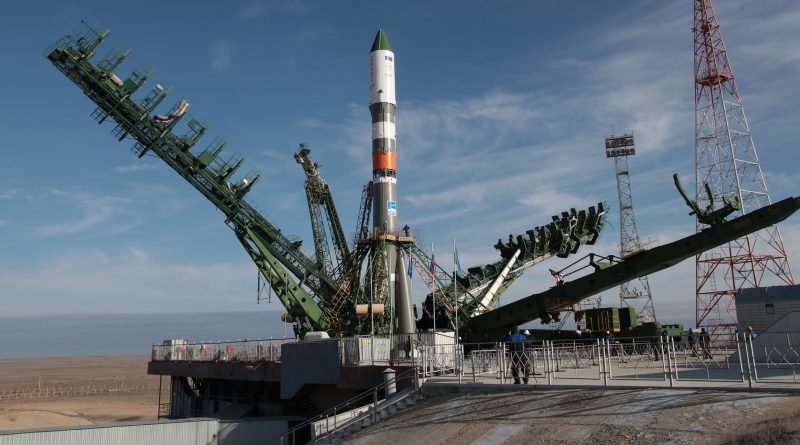Soyuz Rocket counts down to Nighttime Liftoff with Progress Cargo Spacecraft
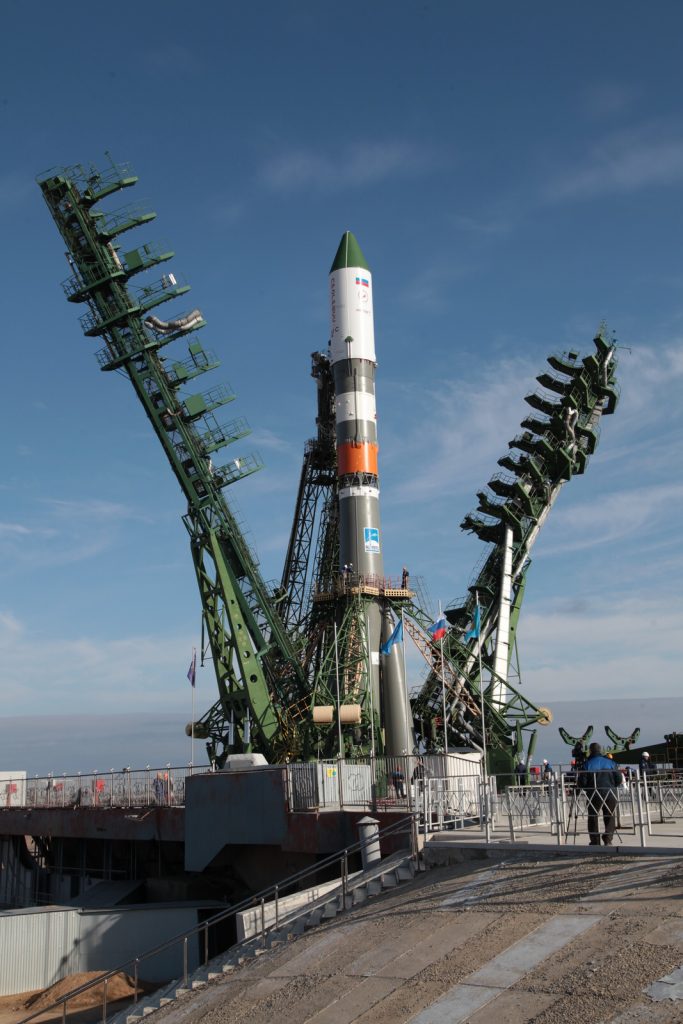
Countdown operations are underway at the Baikonur Cosmodrome for a nighttime liftoff of a Soyuz 2-1A rocket carrying the Progress MS-02 spacecraft into orbit for a two-day trip to the International Space Station. Loaded with over 2,400 Kilograms of cargo, Progress MS-02 is aiming for liftoff on Thursday at 16:23:58 UTC to kick off a nine-minute climb into orbit.
Progress MS-02, the second in the improved MS series of spacecraft, is set for a two-day chase of the Space Station, taking the scenic route to enable engineers on the ground to put the spacecraft and its various new systems through testing while en-route to ISS. This is the last Progress MS flight before the MS upgrade is introduced on the crewed Soyuz in June and teams desire to complete detailed checks of the new systems before flying them on a crewed craft. The first Progress MS flew in December and completed a flawless rendezvous with ISS.
Docking is set for 18:00 UTC on Saturday to mark the second cargo craft arrival at ISS in just one week in a very busy period of visiting vehicle operations that kicked off back on March 18/19 with the arrival of Soyuz TMA-20M and the Expedition 47/48 crew members, Alexey Ovchinin, Oleg Skripochka and Jeff Williams. SpaceX is targeting April 8 for the return to flight of the company’s Dragon spacecraft to become the third vehicle to arrive at ISS in a period of three weeks.
Progress MS-02 is loaded with 2,425 Kilograms of cargo for ISS comprised of 1,418kg of dry cargo in the pressurized cargo module of the spacecraft, 540 Kilograms of refueling propellant to be transferred to ISS, 420 Kilograms of water for crew consumption and oxygen generation, and 47 Kilograms of pressurized oxygen and air to top up the Station’s atmosphere.
The way is clear for the docking of the Progress to Zvezda’s aft port after it was vacated on Wednesday by the final Progress M spacecraft. Progress M-29M entered an independent orbit just below ISS to complete nine days of engineering testing ahead of re-entry.
Countdown & Launch Sequence
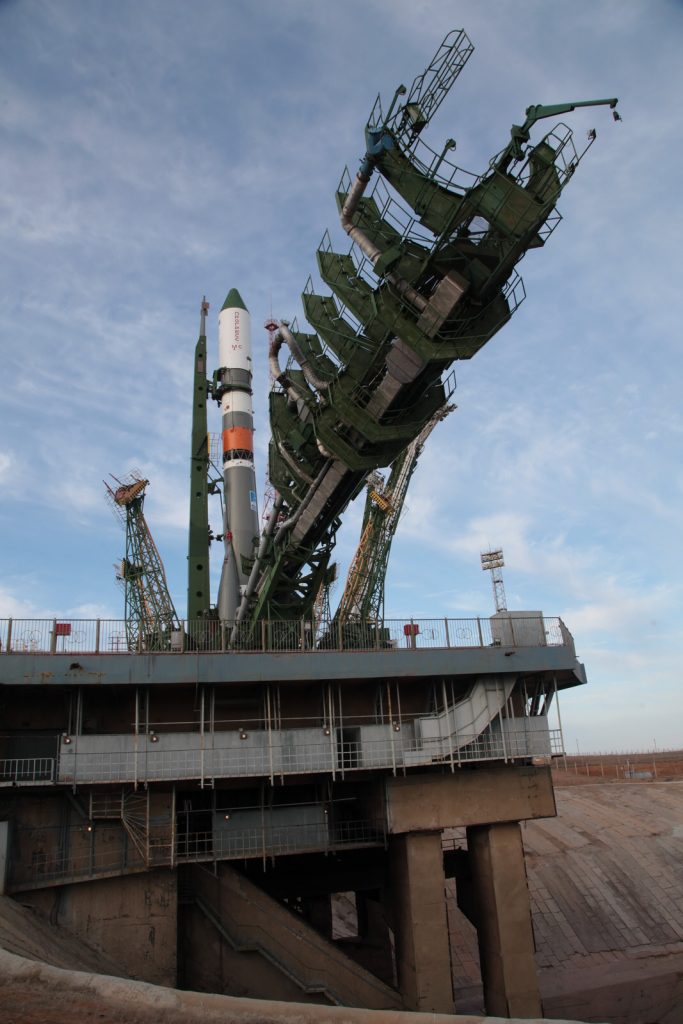
Countdown operations kicked off eight hours ahead of the planned launch time with the activation of the Soyuz launcher and Progress spacecraft for a last round of checkouts and reconfigurations. Communication checks, electrical testing and propulsion system testing is performed in the early stages of the countdown. Completing final hands-on work on the launch vehicle, engineers will install batteries in the booster and remove protective covers from the Soyuz including the first stage engine covers.
Five hours before launch, the Russian State Commission convenes to review the status of launch preparations as well as the results of launch vehicle testing to provide the formal approval for propellant loading. Five hours before launch, the Russian State Commission convenes to review the status of launch preparations as well as the results of launch vehicle testing to provide the formal approval for propellant loading.
At that point, teams will be busy working on the Soyuz as final hands-on tasks and fueling preparations are being made. After the tanking cars pull up to the pad, they are connected to propellant systems to initiate the propellant loading procedure approximately four hours before liftoff. The 12 tanks of the Soyuz will be filled with a total of 272,140 Kilograms of rocket-grade Kerosene and –183°C Liquid Oxygen. In addition, the boosters and core stage are loaded with liquid Nitrogen for tank pressurization and Hydrogen Peroxide to drive the turbopumps of the engines. Fueling wraps up about two hours before launch, allowing teams to perform final close-outs of the launch vehicle and pad structures.
>>Soyuz 2-1A Launch Vehicle Overview
>>Soyuz Countdown Timeline
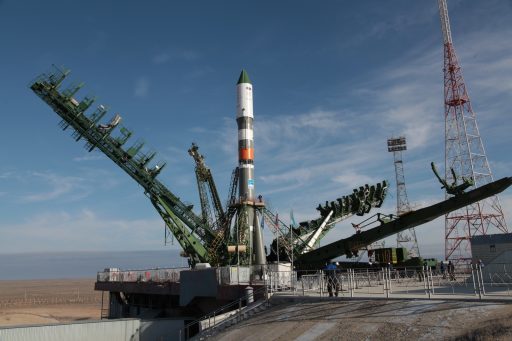
During the final hour of the countdown, the Soyuz will go through a final set of tests and the Service Structure is retracted to clear the way for liftoff.
The Guidance System of the rocket will be configured for launch and teams will evacuate the launch pad ahead of the Terminal Countdown Sequence. Heading into the terminal countdown sequence six minutes before liftoff, the Soyuz completes final reconfigurations including propellant tank pressurization, engine purge, and the transfer to onboard power and control. Twenty seconds before launch, the RD-107A and RD-108A engines on the boosters and Core Stage come to life and soar up to intermediate thrust levels before throttling up to a total liftoff thrust of 422,000 Kilograms.
Liftoff is set for precisely 16:23:58 UTC as Soyuz rises from its pad to climb vertically before beginning to pitch and roll onto its precise ascent trajectory to begin heading to orbit. Roll capability is new for a Progress launch, provided by the digital guidance system of the Soyuz.
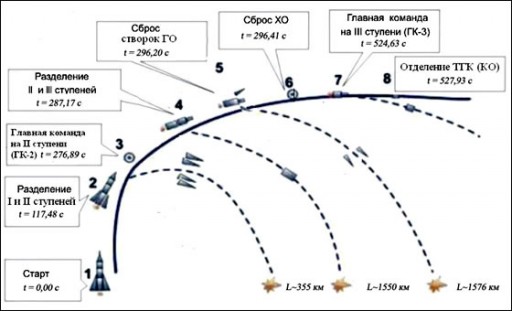
The four liquid-fueled boosters will burn for 1 minute and 57.48 seconds, consuming 39,200 Kilograms of liquid oxygen and Rocket Propellant-1. Separation of the boosters is accomplished using pyrotechnics and pistons that send the four 19.6-meter long boosters into a tumble back to Earth for a crash landing 355 Kilometers downrange from Baikonur (7km further downrange than for Soyuz U).
With the boosters gone, the core stage will continue firing its RD-108A engine, delivering 101 metric tons of thrust to continue powering the vehicle. The Core Stage will burn until T+4:46.89 when its engine will be shut down. Eleven seconds later, the third stage of the Soyuz ignites its engine and the pyrotechnic stage separation system is fired as part of the hot-staging sequence of the Soyuz.
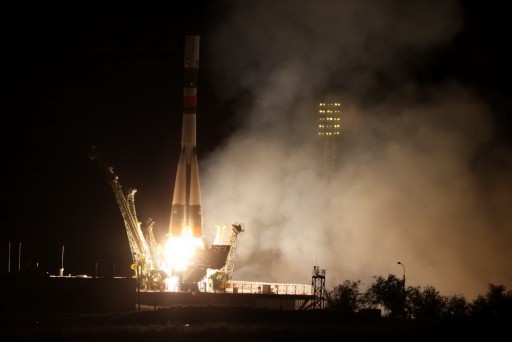
This will enable the third stage to pull away from the spent Core Stage and continue the journey into orbit while the 27.8-meter long core falls back to Earth for impact 1,550 Kilometers downrange (20km short of the Soyuz U impact Zone). Ten seconds after the RD-0110 engine of the third stage ignites, the Soyuz will jettison its payload fairing to expose the Progress for the rest of the way into orbit. The separation of the third stage’s aft section occurs 0.21 seconds before fairing separation to enable all items to impact in the same location, 1,576 Kilometers downrange from the launch site. In any previous Progress ascent mission, the fairing was dropped at T+2 minutes and 40 seconds, but Soyuz 2-1A will hold the fairing for another two minutes and 15 seconds.
The reasoning behind this is to deliberately reduce the overall ascent performance by holding the extra weight of the fairing longer in order to keep the previous drop zones of boosters, core stage and third stage aft-section. Drop-zones for vehicles launching from Baikonur have often been a source of conflict between Russia and Kazakhstan causing several launch delays while negotiations on a political level were underway to clear the way for new drop zones to be approved. By keeping the old drop zones, no hold-up to Progress missions can be expected while the overall performance of the launcher remains the same.
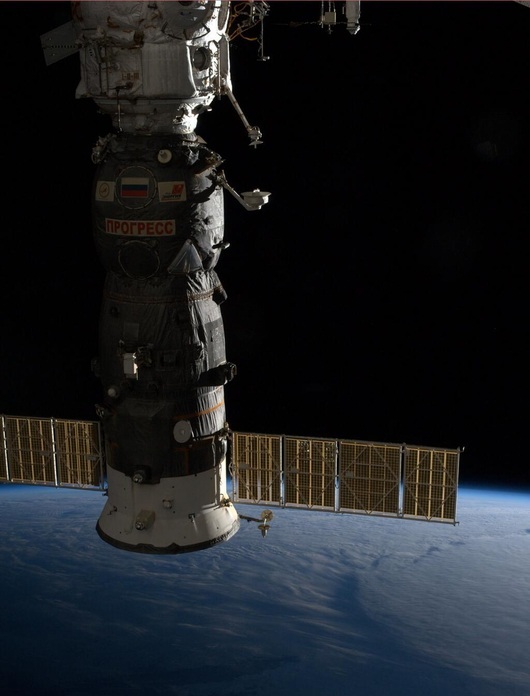
The 298-Kilonewton RD-0110 engine of the Upper Stage performs a 3-minute 58-second engine burn, shutting down in a modified sequence that aims to reduce the shock at engine cutoff and avoid damage to the Block I third stage and Progress spacecraft. With the completion of the burn, the stack will be in orbit with spacecraft separation planned at T+8:47.93.
Progress MS-02 is targeting an insertion orbit of 193 (+/-2) by 240 (+/-7) Kilometers inclined 51.67 degrees. These orbital parameters reflect the increased insertion accuracy delivered by Soyuz 2-1A as the margins for both, perigee altitude and apogee have been reduced significantly. The Progress MS-02 spacecraft is not using the expedited rendezvous profile to ISS in order to leave plenty of time for testing of the spacecraft before coming close to the Space Station.
The standard two-day mission profile calls for a set of two orbit-raising maneuvers to be performed by Progress on its third orbit around Earth. These maneuvers are adjusted after launch based on the initial insertion obit of the craft to deliver Progress to an orbit over 300 Kilometers in altitude with a third burn on Friday, on orbit #18. The Automated Rendezvous will be initiated early on Saturday as Progress begins to use its new KURS-NA System to guide itself to the vicinity of ISS through a series of rendezvous burns, setting up for a flyaround and a completely automated docking to the Zvezda module of ISS expected at 18:00 UTC.

